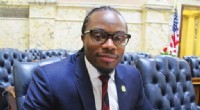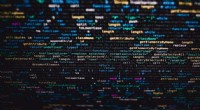
Wetenschap
FBI-agenten houden sociale media in de gaten. Naarmate binnenlandse dreigingen toenemen, is de vraag naar wie ze kijken

Krediet:Pixabay/CC0 publiek domein
Op 11 augustus logde Adam Bies in op zijn account op Gab en begon te typen:
"Ik geloof oprecht dat als je voor de FBI werkt, je het verdient te STERVEN."
Bies, 46, was een beginnend freelance fotograaf die zijn website had gevuld met actiefoto's van snelle auto's en buitensporten. Hij was ontslagen uit zijn dagelijkse baan in marketing omdat hij het COVID-19-vaccin had geweigerd, schreef hij online, en had moeite gehad om een werkloosheidsclaim in te dienen.
Zoals federale openbare aanklagers later zouden beschrijven in gerechtelijke dossiers, vulde Bies zijn dagen met posten onder een pseudoniem op Gab, een sociale-mediadienst die populair is bij rechts-extremisten.
Zijn post bevatte een link naar een Fox News-verhaal over FBI-directeur Christopher Wray die de golf van gewelddadige bedreigingen tegen het bureau in de drie dagen sinds de huiszoeking van het huis en de club Mar-a-Lago van voormalig president Donald Trump afkeurde. Hij vergeleek federale agenten met nazi-troepen. Hij walgde van 'politiestaattuig'. En hij componeerde wat had kunnen worden gezien als een definitief plan.
"Ik weet al dat ik zal sterven door toedoen van deze ... wetshandhavers", schreef hij, afgewisseld met godslastering. "Mijn enige doel is om er meer te doden voordat ik erbij neerval."
Vier dagen later omsingelden gewapende federale agenten en SWAT-teams het huis van Bies, in de buurt van een tuimelende waterval in het diep-woudjachtland van West-Pennsylvania. In het huis waren Bies en zijn 12-jarige zoon. Het was donker, tegen middernacht.
Agenten belden Bies op zijn mobiel, keer op keer, in totaal 16 keer. Ze gaven via een luidspreker het bevel om zich over te geven.
Ten slotte kwam Bies tevoorschijn, met een aanvalsgeweer. Agenten bevalen hem het wapen neer te leggen.
In die vier dagen tussen Bies' bedreigende berichten en het moment dat hij het opnam met gewapende agenten, was hij verstrikt geraakt door een complexe, weinig bekende praktijk binnen de FBI genaamd uitbuiting van sociale media, of SOMEX - een die op dit moment zou kunnen de online activiteiten van iedereen in Amerika in de gaten houden.
Top FBI-leiders hebben geprobeerd de mate te bagatelliseren waarin agenten op legale wijze openbare online activiteiten kunnen volgen van mensen die niet worden onderzocht. Maar in werkelijkheid kan het bureau bijna onbeperkt toezicht houden op openbare sociale media, zolang het dit doet voor wetshandhavingsdoeleinden, vertelden FBI-functionarissen aan U.S. TODAY.
Experts zeggen dat dit de FBI meer macht geeft dan het publiekelijk wilde erkennen - macht die het bureau en andere veiligheidsexperts zeggen dat ze een verantwoordelijkheid hebben om te gebruiken om terrorisme te voorkomen.
Maar critici zeggen dat uitbuiting van sociale media betekent dat agenten online berichten naar believen mogen beoordelen, zonder toezicht, maar met grote autoriteiten.
"FBI-functionarissen hebben veel verkeerde informatie naar buiten gebracht over de reikwijdte van hun autoriteiten", zegt Michael German, een voormalig speciaal agent van de FBI en een medewerker van het Brennan Center for Justice van de New York University. "De FBI heeft enorme bevoegdheden om te onderzoeken lang voordat er een redelijk crimineel predikaat is."
SOMEX, omvat agenten die hun eigen leads ontwikkelen en informatie ontvangen van een netwerk van aannemers en medewerkers, zoals een onderzoeksgroep voor terrorisme die de berichten van Bies voor het eerst heeft gemarkeerd.
Maar het bureau is bekritiseerd vanwege de manier waarop zijn onderzoekers hebben gereageerd – zoals in het geval van online berichten van liberale activisten tijdens de Black Lives Matter-protesten van 2020 – en hoe ze niet reageerden – zoals in de rechtse aanloop naar de opstand van 6 januari.
De FBI is al lang onder de loep genomen wegens overdreven reikwijdte bij het aanmaken van bestanden over publieke figuren en anderen, zelfs als er geen strafrechtelijk onderzoek naar hen liep. En sommige experts zeggen dat het bureau zich in het verleden heeft gericht op linkse groepen zoals milieuactivisten en raciale rechtvaardigheidsactivisten, terwijl het de bedreigingen van blanke supremacisten en anderen aan de rechterkant negeert. Ze zeggen dat deze tendens overgaat in het digitale tijdperk.
En interne gegevens die zijn verkregen door een belangenorganisatie lijken agenten in cyberonderzoek te laten zien die zich specifiek richten op demonstraties tegen de politie en raciale gerechtigheid in plaats van gewapende tegendemonstranten of blanke supremacisten.
"Het probleem met toezicht op sociale media is vaak het probleem met politie in het algemeen, dat is dat de politie misdaad niet kan voorspellen, het enige wat ze kunnen doen is een inschatting maken van welk type persoon het meest waarschijnlijk misdaad zal plegen, en die groep onder toezicht plaatsen ', zegt Matthew Guariglia, beleidsanalist bij de Electronic Frontier Foundation. Die "knie-schokreactie", zei Guariglia, betekent uiteindelijk meer toezicht en intimidatie van mensen van kleur en gemarginaliseerde groepen.
Maar terwijl verontwaardiging over Mar-a-Lago nu bedreigingen van rechts-extremisten tot historisch niveau aanwakkert, stuiten al lang bestaande vragen over hoe de FBI Amerikanen echt online volgt op een nieuwe wending:wat gebeurt er als de mensen die worden bedreigd de FBI-agenten zelf zijn?
FBI heeft meer speelruimte dan velen zich realiseren
In juni vorig jaar, tijdens een hoorzitting van de House Committee on Oversight and Reform, vroeg het New Yorkse congreslid Alexandria Ocasio-Cortez Wray over het onvermogen van de FBI om de chaos van de opstand van 6 januari te voorzien.
"We weten nu dat de aanvallen in het openbaar waren gepland op populaire sociale-mediaplatforms", zei Ocasio-Cortez. "Maakt de FBI regelmatig toezicht op sociale media als onderdeel van haar inspanningen om gewelddadig extremisme te bestrijden?"
Wray's reactie was nadrukkelijk:
"We hebben een zeer specifiek beleid dat al heel lang op de afdeling aanwezig is en dat ons vermogen om sociale media te gebruiken bepaalt. En wanneer we een geautoriseerd doel en de juiste voorspelling hebben, zijn er veel dingen die we kunnen doen op sociale media," zei Wray . "Maar wat we op sociale media niet kunnen doen, is zonder de juiste voorspelling en een geautoriseerd doel, gewoon monitoren."
Maanden eerder gaf Jill Sanborn, voormalig uitvoerend adjunct-directeur voor nationale veiligheid van de FBI, een soortgelijke uitleg aan de Senaatscommissie voor Binnenlandse Veiligheid en Regeringszaken. "We kunnen geen door het Eerste Amendement beschermde activiteiten verzamelen zonder de volgende stap, wat de bedoeling is", zei ze.
Sen. Kyrsten Sinema vervolgde en vroeg:"Dus de FBI houdt geen toezicht op openbaar beschikbare sociale-mediagesprekken?"
"Juist, mevrouw. Het valt niet onder onze bevoegdheden," antwoordde Sanborn.
De eigen regels van de FBI zeggen iets anders.
FBI-functionarissen vertelden V.S. VANDAAG dat de verklaring van Wray correct was, terwijl ze erkenden dat een "geautoriseerd doel" simpelweg betekent dat je iets doet dat in overeenstemming is met de taken van een FBI-agent.
Dat "geautoriseerde doel" is eigenlijk buitengewoon breed. Het beleid zou agenten verbieden om naar sociale media te kijken om bijvoorbeeld een romantische partner in de gaten te houden, of om te controleren op ander niet-wetshandhavingsgebruik. Maar het zou een agent in staat stellen om in wezen alles online te bekijken, proactief, als het de bedoeling was een misdaad te stoppen of Amerikanen te beschermen. Een FBI-functionaris noemde dit vallen binnen de 'halfschaduw van nationale veiligheid, handhaving van federale wetgeving of buitenlandse inlichtingen'.
German, a fellow with the Brennan Center's Liberty and National Security Program, argued in a recent report that individual FBI agents have extraordinary leeway to look through public-facing social media posts without seeking authorization from their superiors in advance or even keeping an official record of their actions.
The FBI rules, laid out in their handbook and periodically updated Attorney General's guidelines, allow agents to conduct "pre-assessments" of possible threats, German said. Those pre-assessments can be conducted "without any factual basis to suspect wrongdoing," German writes in his report.
He and several other experts agree that the FBI certainly can, then, proactively monitor Americans' social media for signs of unrest, dissent or violence that might lead to criminal activity.
FBI officials told U.S. TODAY this is correct. There's no need for "proper predication," or evidence of a crime, when conducting a pre-assessment of a subject.
German's analysis of the rules was echoed by Brian Murphy, a former top FBI official who helped pioneer the FBI's social media exploitation efforts.
He cited Sanborn's statements, telling U.S. TODAY, "I just think that she was wrong." He said the agency has a risk-averse culture that prevents agents and managers from taking the steps necessary to fully protect Americans.
Sanborn, who is no longer at the FBI, did not respond to messages seeking comment. An FBI spokesperson said Sanborn's comments referred specifically to "conversations" on social media and not to public-facing posts by individuals.
While the bureau describes its authorities carefully, its agents—and third party contractors—can track critics of the government like Adam Bies, watching until their online rantings cross a line into outright threats.
Then the FBI can act.
What SOMEX really looks for
The FBI's SOMEX team, which sits within the agency's National Threat Operations Center in Clarksburg, West Virginia, receives and investigates tips on imminent social media threats from concerned citizens, other law enforcement agencies, independent monitoring organizations and others.
But the effort involves more than just acting as a catcher's mitt for incoming tips. It also develops its own social media intelligence.
Documents obtained by the open-government group Property of the People (and first reported by Rolling Stone) give insight into the broader social media monitoring role SOMEX plays inside the FBI. The documents detail reports from the team to federal and local law enforcement in the Seattle area during the civil unrest that unfolded in the wake of the murder of George Floyd.
"While overnight social media activity was very light, the SOMEX team did find some tweeting by individuals stating they would monitor police radio activity," reads a typical extract from the documents, taken from a June 2, 2020 situation report emailed to dozens of FBI agents.
"The FBI aggressively scours social media for information related to topics of Bureau interest," said Ryan Shapiro, executive director and co-founder of the nonprofit group, which provided U.S. TODAY with hundreds of pages of documents about the FBI's social media monitoring that it acquired through open records requests. "This routinely includes surveillance of Americans who are not the subject of an investigation or even suspected of committing a crime."
In a statement, the FBI said that SOMEX was created to assist in identifying "unknown subject, victim, or location information" when there's a threat to life by using publicly available information. The team then forwards information to the appropriate agency for further investigation and appropriate action.
FBI officials told U.S. TODAY that agents are not allowed to use specific SOMEX tools without additional training in privacy and civil liberties protections. Those tools include commercial software the FBI purchases to use in-house. The FBI also works with third-party contractors for social media analysis, the officials said.
One contractor is the private intelligence firm the Hetherington Group, which has trained law enforcement and the military on conducting online investigations.
Cynthia Hetherington, the firm's founder and president, said the company identifies "actionable intelligence" that can be used to protect life or someone's reputation by helping those it trains learn how to hyperfocus and efficiently identify a key collection of terms that demonstrate legitimate threats, such as "kill," "die," "shoot," "fire," "bomb," "rob."
"Individuals should be allowed to say what they want to say on the internet, but should also understand that it's open source and the parties concerned will trace it back" to them, Hetherington said.
Another way of saying that, said Shapiro, who holds a doctorate from the Massachusetts Institute of Technology focusing on government surveillance, is that the FBI can, and is, monitoring practically whoever it wants, whenever it wants.
"The FBI is almost entirely unhindered in its ability to monitor American social media postings," Shapiro said, "So when the FBI reported to Congress that it was unable to do so—I mean, that is a bald-faced lie. That's what the bureau does. They lie."
As the FBI becomes more interested in specific posts, the bureau can also ramp up its monitoring in more "intrusive" ways, FBI officials said. With additional internal approvals, FBI agents can access not just public-facing social media, but also private groups and chat rooms.
Even when accessing this more private information, the FBI's internal checks don't protect Americans' civil liberties, several experts told U.S. TODAY.
The FBI has a long and troubled history of focusing on groups on the left of the political spectrum while largely turning a blind eye to domestic extremists on the far-right, said Guariglia, who holds a doctorate in the history of police surveillance.
"Both historically speaking, and in current events, we've seen the amount of surveillance that has been marshaled specifically against groups fighting for racial justice increased exponentially than from what we've seen being monitored on the right," Guariglia said.
The FBI pushed back on this assessment. "The FBI aggressively investigates threats posed by domestic violent extremists," a bureau spokesperson wrote in a statement. "We do not investigate ideology and we do not investigate particular cases based on the political views of the individuals involved."
Are there enough resources to do the work?
The FBI isn't the only law enforcement agency doing social media exploitation.
The bureau's SOMEX team is part of a constellation of social media analysis that has occurred across the national security apparatus over the few years. The Department of Homeland Security has its own SOMEX team plus social media analysts at dozens of "fusion centers" across the U.S. sharing intelligence with local, state and federal law enforcement, said Mike Sena, executive director of one of those fusion centers, the Northern California Regional Intelligence Center.
The FBI also works to train and assist local police departments in their social media exploitation efforts, a tactic that came to light earlier this year in a report by the Intercept, which detailed how the bureau provided the Chicago Police Department with fake social media accounts to investigate demonstrators outraged at the Floyd murder by police officers in 2020.
The San Bernardino terrorist attack in 2015 turned out to be a "proof of concept" on the efficacy of social media analysis, Hetherington said, when reporting from Facebook to a fusion center social media analyst helped the FBI quickly identify the people involved.
But using social media analysis to identify future crimes, rather than research past ones, is a broader net. That federal effort to prevent crimes is still small given the scale of the internet, Sena said.
"Most people would be shocked in America," Sena said. "There's a small number of folks trying to deal with these threats that are huge."
Sena and Hetherington told U.S. TODAY that after the ACLU of California publicized law enforcement's use of commercial software to "monitor activists and protesters" in 2016, many companies stopped selling their software to law enforcement or minimized their capacity to use it to track online activity.
As a result, Sena said, "our people are manually doing things, they're doing the work, but they're having to work 10 times as hard as they used to."
That's why agencies plan to bring their teams together, at least virtually, to break up siloes and avoid duplication, Sena said. One byproduct of this effort, he said, will be fewer blindspots or gaps that can be used to accuse law enforcement of bias.
"Even if you're being proactive, it's basically walking with a teaspoon at a river and trying to put that in a bucket," Sena said. "We're not getting everything, but it's better than nothing."
But German argues in his report that the majority of social media exploitation work is actually counterproductive. The sheer volume of tips generated by contractors and the FBI's own analysts results in an "information overload," German writes.
"Obviously, the multiple forms of social media monitoring that the FBI and other law enforcement agencies conducted prior to January 6 was not helpful in preparing for the attack," the report states. "Yet after the Capitol insurrection, the FBI invested an additional $27 million into social media monitoring software, effectively doubling down on a failed methodology."
Ongoing investment in social media exploitation
Those efforts continue even in the weeks since the Mar-a-Lago search and backlash.
Three days after the FBI executed its Aug. 8 search warrant on Mar-a-Lago and was inundated by right-wing threats, Ricky Shiffer, a 42-year-old Navy veteran, walked into the FBI office in Cincinnati armed with a nail gun and an AR-15 rifle.
As U.S. TODAY reported, Shiffer had spent the last nine days of his life ranting on Truth Social, the social media company founded by Trump. His hundreds of posts included explicit threats against the federal government including "Kill F.B.I. on sight."
When his attack failed, Shiffer fled north along rural highways and into a standoff where was ultimately shot and killed.
The FBI said in a statement that it had been informed of Shiffer but that "the information did not contain a specific and credible threat."
Wray told the agency in a message the day after that attack that the FBI's security division would be adjusting its "security posture accordingly."
A $32,400 contract approved Monday—after discussion that started weeks before the search of Mar-a-Lago, Hetherington said—notes that the agency will hire the Hetherington Group to train its agents on SOMEX later this month.
According to a document the bureau filed to justify making the purchase without opening it up to bidding, "it is an immediate need to expand and broaden the social media knowledge for the NTOS SOMEX team." The FBI wrote that the training can provide it with expertise in the "forces and factors that lead to the radicalization of terrorism specifically white supremacy extremism."
That document was filed Aug. 11, the same day Shiffer carried a nail gun into an FBI office, then fled into the Ohio cornfields.
It was also the same day Adam Bies was logging post after post on Gab.
'Why don't you send them my threats'
As Bies tapped out his messages, he wasn't just speaking to his 1,600 followers. According to court documents, he also deliberately tagged Gab founder Andrew Torba in his posts, goading him to report Bies to the federal government.
"Why don't you send them my threats so that they'd at least have something credible to show on Fox News," Bies wrote in the post. "Just scrub my timeline for the posts you didn't delete after you threatened to ban me."
Also watching Bies' posts was a third-party media monitoring and analysis firm, the Middle East Media Research Institute. MEMRI cut its teeth monitoring Middle Eastern media for English-speaking audiences, but over the last three years has expanded to real-time social media monitoring, specifically for threats from white supremacists and other homegrown extremists.
"We're consistently in communication with (law enforcement and government) agencies at the local, state and national level, and providing" them with actionable intelligence, said Simon Purdue, director of MEMRI's Domestic Terror Threat Monitor team. "Having people like us helps speed things along."
MEMRI alerted the FBI, according to a later criminal complaint. The FBI contacted Gab, who handed over Bies' subscriber information and Internet Protocol logs for his computer connection. Soon, agents were outside his Mercer County home.
After a 30 or 40 minute stand-off at his home, Bies eventually emerged carrying an assault rifle, an FBI agent testified in court. Agents told him several times to drop the weapon, which he eventually did.
Had he not done so, the agent testified, according to local media reports, "It would have ended differently."
Bies' son left the house safely. Inside the home, agents found 12 other guns and a compound bow. Bies was taken into custody and charged under a law that covers making threats against a federal law enforcement officer.
He has pleaded not guilty and is being held awaiting trial. + Verder verkennen
US plans for fake social media run afoul of Facebook rules
(c)2022 USA Today
Distributed by Tribune Content Agency, LLC
 Meren veranderen wereldwijd
Meren veranderen wereldwijd NASA krijgt een infraroodbeeld van tropische cycloon Sanvu
NASA krijgt een infraroodbeeld van tropische cycloon Sanvu Kleine vulkaanuitbarstingen kunnen leiden tot een wereldwijde catastrofe, experts beweren:
Kleine vulkaanuitbarstingen kunnen leiden tot een wereldwijde catastrofe, experts beweren: Omkeerbare elektro-optische detector voor omgevingsdetectie van verontreinigende stoffen
Omkeerbare elektro-optische detector voor omgevingsdetectie van verontreinigende stoffen Hoe Brexit het klimaatbeleid van het VK ten goede kan komen
Hoe Brexit het klimaatbeleid van het VK ten goede kan komen
Hoofdlijnen
- Celstructuren en hun drie belangrijkste functies
- Waarom blijven liedjes in mijn hoofd hangen?
- Hoe Charles Darwin werkte
- Stadsuitbreiding in Perth die het seksleven van planten beïnvloedt
- DNA is gecondenseerd in welke fasen?
- Angiogenese versus vasculogenese
- Pareidolie:waarom we in bijna alles gezichten zien
- Verschil tussen gekoppelde en vrijstaande ribosomen
- Duplicaties van niet-coderend DNA kunnen de evolutie van mensspecifieke eigenschappen hebben beïnvloed
- Fiat-Chrysler en GM sluiten zich aan bij Ford om productie te verminderen na fabrieksbrand

- Wetsvoorstel Maryland streeft naar transparantie in online politieke advertenties

- AI kan een kracht zijn voor positieve sociale verandering, maar stevent momenteel af op een donkere toekomst

- Fietser/automobilist aanrijdingen erger op stop/voorrangskruispunten

- Geen muzikaal talent, geen probleem, daar zijn nu apps voor

 Terahertz-licht van supergeleidende strepen
Terahertz-licht van supergeleidende strepen Lichtgevende nanobuisjes worden helderder in nuldimensionale toestanden
Lichtgevende nanobuisjes worden helderder in nuldimensionale toestanden Veelgebruikte efficiëntietool voor non-profitorganisaties werkt niet, studie zegt:
Veelgebruikte efficiëntietool voor non-profitorganisaties werkt niet, studie zegt: Uitbarstingen van zonnen kunnen allemaal dezelfde trigger hebben
Uitbarstingen van zonnen kunnen allemaal dezelfde trigger hebben Grote aardbeving Mexico veroorzaakt schade, één dood
Grote aardbeving Mexico veroorzaakt schade, één dood Lancering van lekkende sites toont dilemma van radicale transparantie
Lancering van lekkende sites toont dilemma van radicale transparantie Huawei's AI-aangedreven smartphone bestuurt een Porsche
Huawei's AI-aangedreven smartphone bestuurt een Porsche Een zwart gat in een röntgendubbelster met lage massa
Een zwart gat in een röntgendubbelster met lage massa
- Elektronica
- Biologie
- Zonsverduistering
- Wiskunde
- French | Italian | Spanish | Portuguese | Swedish | German | Dutch | Danish | Norway |

-
Wetenschap © https://nl.scienceaq.com

